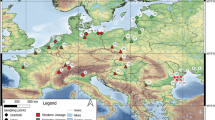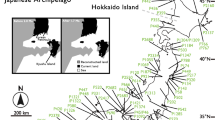Abstract
Prior studies of the hydrothermal vent mussel Bathymodiolus thermophilus (Bivalvia: Mytilidae), provided conflicting predictions about the dispersal ability and population structure of this highly specialized species. Analyses of morphological features associated with its larval shells revealed a feeding larval stage that might facilitate dispersal between ephemeral vent habitats. In contrast, an allozyme study revealed substantial genetic differentiation between samples taken from populations 2370 km apart on Galápagos Rift (Latitude 0°N) and the East Pacific Rise (13°N). To resolve the discrepancy between these studies, we examined allozyme and mitochondrial (mt) DNA variation in new samples from the same localities plus more recently discovered sites (9° and 11°N) along the East Pacific Rise. Although analysis of 26 enzyme-determining loci revealed relatively low levels of genetic variation within the five populations, no evidence existed for significant barriers to dispersal among populations. We estimated an average effective rate of gege flow (Nm) of ≃ 8 migrants per population per generation. Two common mtDNA variants predominated at relatively even frequencies in each population, and similarly provided no evidence for barriers to gene flow or isolation-by-distance across this species' known range. Larvae of this species appear to be capable of dispersing hundreds of kilometers along a continuous ridge system and across gaps separating non-contiguous spreading centers.
Similar content being viewed by others
References
Bayne BL (1965) Growth and delay of metamorphosis of the larvae of Mytilus edulis (L.) Ophelia 2: 1–47
Bayne BL (1971) Some morphological changes that occur at the metamorphosis of the larvae of Mytilus edulis. Cambridge University Press, London
Bayne BL (1976) The biology of mussel larvae. In: Bayne BL (eds) Marine mussels. Cambridge University Press, Cambridge, pp 81–120
Berg CJ Jr. (1985) Reproductive strategies of mollusks from abyssal hydrothermal vent communities. Bull biol Soc Wash 6: 185–197
Birky CW Jr. (1991) Evolution and population genetics of organelle genes: mechanisms and models. In: Selander RK, Clark AG, Whittam TS (eds) Evolution at the molecular level. Smaue Associates, Inc., Sunderland, Mass, pp 112–134
Black MB, Lutz RA, Vrijenhoek RC (1994) Gene flow among vestimentiferan tube worm (Riftia pachyptila) populations from hydrothermal vents of the eastern Pacific. Mar Biol 120: 33–39
Butterfield DA, Massoth GJ, McDuff RE, Lupton JE, Lilley MD (1990) The chemistry of phase separated hydrothermal fluids from axial seamount hydrothermal emissions study (ASHES) vent field, Juan de Fuca Ridge: subseafloor boiling and subsequent fluid-rock interaction. J geophys Res 95: 12895–12921
Chakraborty R, Danke-Hopfe H (1991) Analysis of population structure: a comparative study of different estimators of Wright's fixation indices. In: Roa CR, Chakraborty R (eds) Handbook of statistics. Elsevier, Amsterdam, pp 203–254
Chanley P, Andrews JD (1971) Aids for identification of bivalve larvae of Virginia. Malacologia 11: 45–119
Clayton JW, Tretiak DW (1972) Amine-citrate buffers for pH control in starch gel electrophoresis. J Fish Res Bd Can 29: 1169–1172
Craddock C, Hoeh WR, Gustafson RG, Lutz RA, Hashimoto J, Vrijenhoek RC (1995) Evolutionary relationships among deep-sea mytilids (Bivalvia: Mytilidae) from hydrothermal vents and cold-water methane/sulfide seeps. Mar Biol 121: 477–485
Crow J, Kimura M (1970) An introduction to population genetics theory. Harper & Row. New York
Crow JF, Aoki K (1984) Group selection for a polygenic behavioral trait: estimating the degree of population subdivision. Proc natn Acad Sci USA 81: 6073–6077
De Schweinitz EH, Lutz RA (1976) Larval development of the northern horse mussel, Modiolus modiolus (L.), including a comparison with the larvae of Mytilus edulis (L.) as an aid in planktonic development. Biol Bull mar biol Lab, Woods Hole 150: 348–360
Desbruyères D, Crassous P, Grassle J, Khripounoff A, Reyss D, Rio M, Van Praet M (1982) Biological observations on new submarine thermal springs on East Pacific Rise. C r Acad Sci, Paris 295: 489–494
Dowling TE, Moritz C, Palmer JD (1990) Nucleic acids. II. restriction site analysis. In: Hillis DM, Moritz C (eds) Molecular systematics. Sinauer Associates Inc. Sunderland, Massachusetts, pp 256–317
Fisher C, Skibinski DOF (1990) Sex-biased mitochondrial DNA heteroplasmy in the marine mussel Mytilus. Proc R Soc (Ser B) 242: 149–156
France sC, Hessler RR, Vrijenhoek RC (1992) Genetic differentiation between spatially-disjunct populations of the deep-sea, hydrothermal vent-endemic amphipod Ventiella sulfuris. Mar Biol 114: 551–559
Grassle JF (1986) The ecology of deep-sea hydrothermal vent communities. Adv mar Biol 23: 301–362
Grassle JP (1985) Genetic differentiation in populations of hydrothermal vent mussels (Bathymodiolus thermophilus) from the Galapagos Rift and 13°N on the East Pacific Rise. Bull biol Soc Wash 6: 429–442
Haldane JBS (1954) An exact test for randomness of mating. J Genet 52: 631–635
Haymon RM, Fornari DJ, Von Damm KL, Lilley MD, Perfit MR, Edmonds JM, Shanks WC III, Lutz RA, Grebmeir JM, Carbotte S, Wright D, McLaughlin E, Smith M, Beedle N, Olson E (1993) Volcanic eruption of the mid-ocean ridge along the East Pacific Rise crest at 9°45–52′N: direct submersible observations of seafloor phenomena associated with an eruption event in April, 1991. Earth planet Sci Lett 119: 85–101
Hebert PDN, Beaton M (1989) Methodologies for allozyme analysis using cellulose acetate gels. Helena Laboratories, Beaumont, Texas
Hoeh WR, Blakley KH, Brown WM (1991) Heteroplasmy suggests limited biparental inheritance of Mytilus mitochondrial DNA. Science, NY 251: 1488–1490
Hu Y-P, Lutz RA, Vrijenhoek RC (1992) Electrophoretic identification and genetic analysis of bivalve larvae. Mar Biol 113: 227–230
Kenk VC, Wilson BR (1985) A new mussel (Bivalvia, Mytilidae) from hydrothermal vents in the Galapagos Rift zone. Malacologia 26: 253–271
Kimura M, Weiss WH (1964) The stepping stone model of genetic structure and the decrease of genetic correlation with distance. Genetics, Austin, Tex 49: 561–576
Li CC, Horvitz DG (1953) Some methods of estimating the inbreeding coefficient. Am J hum Genet 95: 107–117
Liu H-P, Mitton JP, Wu S-K (1995) Gender-specific mitochondrial DNA within and among populations of the freshwater mussel, Anodonta grandis grandis. Evolution (in press)
Loosanoff VL, Davis HC, Chanley PE (1966) Dimensions and shapes of larvae of some marine bivalve mollusks. Malacologia 4: 351–435
Lutz RA (1988) Dispersal of organisms at deep-sea hydrotermal vents: a review. Oceanol Acta 8: 23–30
Lutz RA, Bouchet P, Jablonski D, Turner RD, Waren A (1986) Larval ecology of mollusks at deep-sea hydrothermal vents. Am malac Bull 4: 49–54
Lutz RA, Jablonski D, Rhoads DC, Turner RD (1980) Larval dispersal of a deep-sea hydrothermal vent bivalve from the Galápagos Rift. Mar Biol 57: 127–133
Lutz RA, Jablonski D, Turner RD (1984) Larval development and dispersal at deep-sea hydrothermal vents. Science, NY 226: 1451–1454
Lutz RA, Kennish MJ (1993) Ecology of deep-sea hydrothermal vent communities: a review. Rev Geophys 31: 211–242
Lutz RA, Rhoads DC, Jablonski D, Turner RD (1979) High larval dispersal capability of a deep-sea hydrothermal vent bivalve from the Galapagos Rift. Am Zool 19: p 927
Lutz RA, Shank TM, Fornari DJ, Haymon RM, Lilley MD, Von Damm KL, Desbruyères D (1994) Rapid growth at deep-sea vents. Nature, Lond 371: 663–664
Lynch M, Crease TJ (1990) The analysis of population survey data on DNA sequence variation. Molec Biol Evolut 7: 377–394
Malécot G (1968) The mathematics of heredity. W.H. Freeman & Co., San Francisco
McCauley DE (1991) Genetic consequences of local population extinction and recolonization. Trends Ecol Evolut 6: 5–8
McConachy TF, Ballard RD, Mottl MJ, Von Herzen RP (1986) Geologic form and setting of a hydrothermal vent field at latitude 10°56′N. East Pacific Rise: a detailed study using ANGUS and ALVIN. Geology (Boulder, Colorads) 14: 295–298
McElroy D, Moran P, Bermingham E, Kornfield I (1992) REAP: an integrated environment for the manipulation and phylogenetic analysis of restriction data. J Hered 83: 157–158
Murphy RW, Sites JW Jr., Buth DG, Houfler CH (1990) Proteins. I. Isozyme electrophoresis. In: Hillis D, Moritz C (eds) Molecular systematics, Sinauer Associates Inc, Sunderland, Mass, pp 45–126
Nei M (1978) Estimation of average heterozygosity and genetic distance from a small number of individuals. Genetics, Austin, Tex 89: 583–590
Nei M (1987) Molecular evolutionary genetics. Columbia University Press, New York
Nei M, Chesser RK (1983) Estimation of fixation indices and gene diversities. Ann hum Genet 47: 253–259
Nei M, Li. WH (1979) Mathematical model for studying genetic variation in terms of restriction endonucleases. Proc natn Acad Sci USA 76: 5269–5273
Roff DA, Bentzen P (1989) The statistical analysis of mitochondrial DNA polymorphisms: χ2 and the problem of small samples. Molec Biol Evolut 6: 539–545
Rohlf FJ (1988) NTSYS-pc: numerical taxonomy and multivariate analysis system. Version 1. 50. Exeter Publishing, Ltd. Setauket, New York
Selander RK, Smith MH, Yang SY, Johnson WE, Gentry JR (1971) Biochemical polymorphism and systematics in the genus Peromyscus. I. Variation in the old-field mouse (Peromyscus polionotus). Stud Genet, Austin, Tex 7103: 49–90
Skibinski DOF, Cross TF, Ahmad M (1980) Electrophoretic investigation of systematic relationships in the marine mussels Modiolus modiolus L., Mytilus edulis L., and Mytilus galloprovincialis Lmk. (Mytilidae; Mollusca) Biol J Linn Soc 13: 73137–73183
Skibinski DOF, Gallagher C, Benyon CM (1994a) Mitochondrial DNA inheritance. Nature, Lond 368: 817–818
Skibinski DOF, Gallagher C, Benyon CM (1994b) Sex-limited mitochondrial DNA transmission in the marine mussel Mytilus edulis. Genetics, Austin, Tex 138: 801–809
Slatkin M (1985) Rare alleles as indicators of gene flow. Evolution 39: 53–65
Slatkin M (1993) Isolation by distance in equilibrium and non-equilibrium populations. Evolution 47: 264–279
Slatkin M, Barton NH (1989) A comparison of three indirect methods for estimating average levels of gene flow. Evolution 43: 1349–1368
Slatkin M, Maddison WP (1989) A cladistic measure of gene flow inferred from the phylogenies of alleles. Genetics, Austin, Tex 123: 603–613
Slatkin M, Maddison WP (1990) Detecting isolation by distance using phylogenies of genes. Genetics, Austin, Tex 126: 249–260
Southward EC (1988) Development of the gut and segmentation of newly settled stages of Ridgeia (Vestimentifera): implications for relationship between Vestimentifera and Pogonophora. J mar biol Ass UK 68: 465–487
Swofford DL, Selander RK (1981) BIOSYS-1: a Fortran program for the comprehensive analysis of electrophoretic data in population genetics and systematics. J Hered 72: 281–283
Takahata N, Palumbi SR (1985) Extranuclear differentiation and gene flow in a finite island model. Genetics, Austin, Tex 109: 441–457
Tunnicliffe V (1991) The biology of hydrothermal vents: ecology and evolution. Oceanogr mar Biol A Rev 29: 319–407
Turner RD, Lutz RA (1985) Growth and distribution of mollusks at deep-sea vents and seeps. Oceanus 27: 55–62
Vrijenhoek RC, Schutz SJ, Gustafson RG, Lutz RA (1994) Cryptic species of deep-sea clams (Mollusca, Bivalvia, Vesicomyidae) in hydrothermal vent and cold-seep environments. Deep-Sea Res 41: 1171–1189
Wahlund S (1928) Zusammensetzung von Populationen und Korrelationerscheinungen vom Standpunkt der Vererbungslehre ans betrachtet. Hereditas 11: 65–106
Weir BS, Cockerham CC (1984) Estimating F-statistics for the analysis of population structure. Evolution 38: 1358–1370
Workman PL, Niswander DJ (1970) Population studies on the southwestern Indian tribes. II. Local differentiation in the Papago. Am J hum Genet 22: 24–49
Wright S (1931) Evolution in Mendelian populations. Genetics, Austin, Tex 16: 97–159
Wright S (1943) Isolation by distance. Genetics, Austin, Tex 28: 114–138
Zouros E, Ball AO, Saavedra C, Freeman KR (1994a) Mitochondrial DNA inheritance. Nature, Lond 368: p. 818
Zouros E, Ball AO, Saavedra C, Freeman KR (1994b) An unusual mitcchondrial DNA inheritance in the blue mussel Mytilus. Proc natn Acad Sci USA 91: 7463–7467
Zouros F, Freeman KR, Ball AO, Pogson GH (1992) Direct evidence for extensive paternal mitochondrial DNA inheritance in the marine mussel Mytilus. Nature, Lond 359: 412–414
Author information
Authors and Affiliations
Additional information
Communicated by N.H. Marcus, Tallahassee
Rights and permissions
About this article
Cite this article
Craddock, C., Hoeh, W.R., Lutz, R.A. et al. Extensive gene flow among mytilid (Bathymodiolus thermophilus) populations from hydrothermal vents of the eastern Pacific. Marine Biology 124, 137–146 (1995). https://doi.org/10.1007/BF00349155
Received:
Accepted:
Issue Date:
DOI: https://doi.org/10.1007/BF00349155




